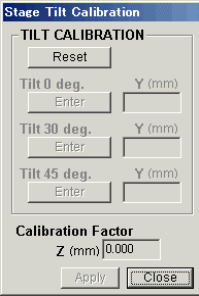
3 - 65
(e) The specimen rotates to an angle of 90°. Again bring the point of interest to the center
and click Enter button.
(f) In the same way, each click of Enter button rotates the specimen 45° at a time.
Bring the point of interest to the center each time and then click Enter. Upon clicking
Enter at a rotation angle of 315°, a Calibration Factor is calculated and indicated. This
value is the stage coordinate at the rotation center, and is normally within 35 ±
1 mm and 55 ±1 mm. After clicking Apply button, click Close button to close the
window.
(4-2) Stage tilt calibration
It measures the deviation of the tilting center from the beam irradiation point.
(a) Insert a specimen, set WD at 30 mm, tilt at 0° and R at 0°, then search for a structure of
interest near the specimen center.
(b) Select Stage Calibration – Tilt center command in the Option menu. The Stage Tilt
Calibration dialog window will open.
(c) Click the Reset button. The following message indicating steps of operation will be shown.
[Move a remarkable object to the center of image and click Enter button for Tilt 0°. Stage
will move to 30deg. and then to 45°.Move the object to the center of image and click
Enter button for each tilt angle. Click Apply button and close the dialog.]
As described in the message, bring the point of interest to the image center at a
magnification of about 500×, then click Enter button of Tilt 0°.
(d) The stage will be driven to a tilt angle of 30°. Bring the point of interest to the image
center and click Enter button of Tilt 30°.
(e) The stage will be driven to a tilt angle of 45°. Again bring the point of interest to the image
center and click Enter button of Tilt 45°.
A Calibration Factor is now calibrated and indicated. This value represents the
deviation of specimen height from the reference position. Click Apply button, then click
Close button to close the window.
(4-3) Z axis compensation
It measures the shift of the stage caused by changing Z axis position.


















